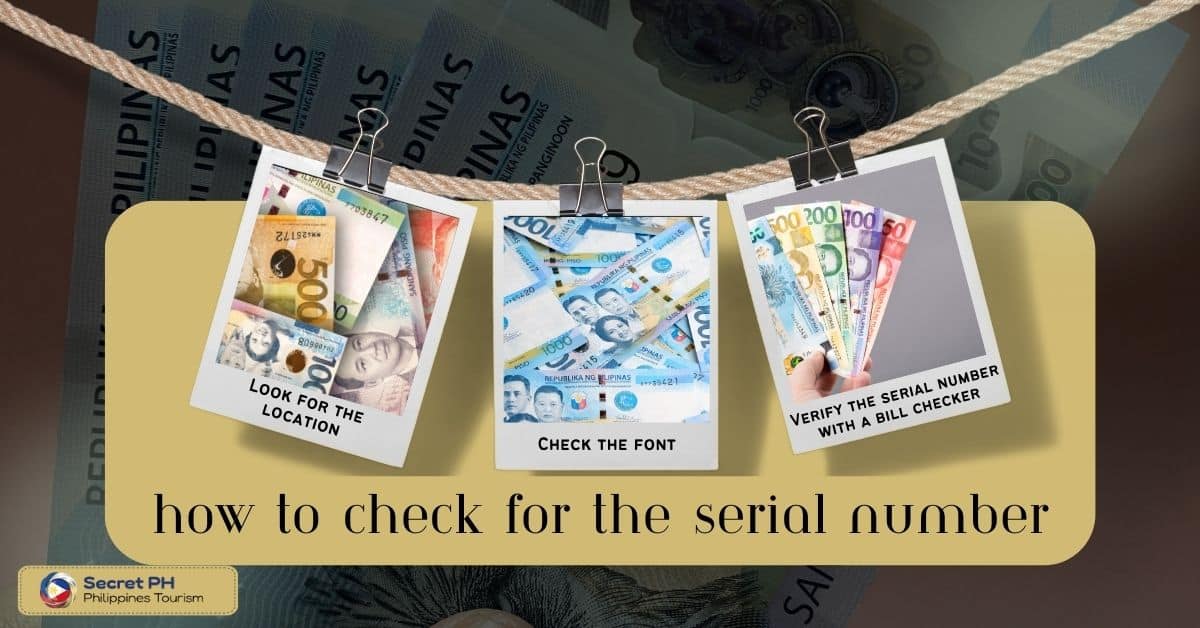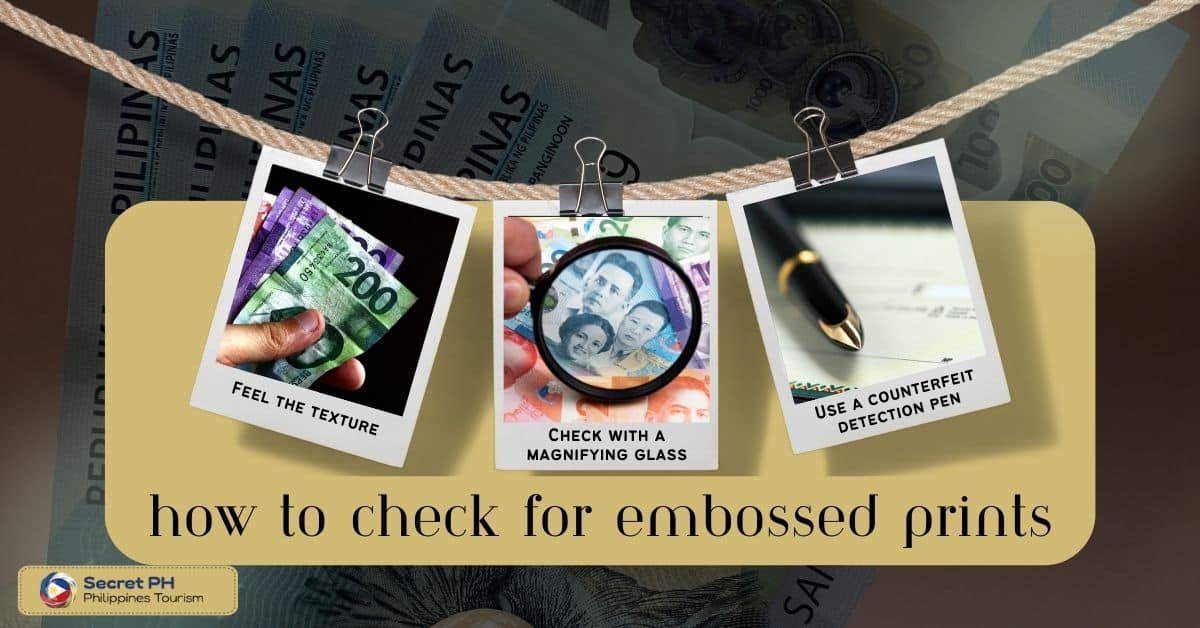The Philippine currency has six security features to prevent counterfeiting. These features include a watermark, security thread, see-through register, optically variable ink, serial number, and embossed prints. Knowing how to check for these features can help you spot counterfeit bills and protect yourself from financial fraud.
In this article, we will discuss the six security features of Philippine currency and how you can use them to spot counterfeit bills. Knowing these features can help you protect yourself from fraud and ensure that you only handle legitimate currency. Let’s dive into the details and learn how to spot counterfeit bills with ease.

Security Features of Philippine Currency
The security features of the Philippine currency are designed to ensure the protection of each individual’s money. High-tech materials, such as holograms, optically variable magnetic images, and color-shifting ink have been incorporated into the latest banknote. New notes contain low visibility embedded fibers that can only be seen when held up to a light source.
Modernized banknotes also include intricate designs such as symbols or codes featuring icons related to Filipino culture. Lastly, there are advanced watermark images found on current Philippine pesos that are visible when held at an angle. These innovations make it more difficult for people to produce fake Philippine cash, guaranteeing you peace of mind with every transaction.

Watermark
The watermark feature is an important aspect of Philippine currency. It is a highly technical security measure which makes it difficult to counterfeit money. All denominations of Philippine banknotes include a portrait watermark of the country. This custom designed portrait is enlarged and repeated across the entire surface of each banknote.
The watermark can be appreciated when held up against a strong light source. The portraits appear raised and three-dimensional on the note’s paper surface. It is also combined with other intricate security features to ensure that each Philippine banknote remains genuine.

How to check for the watermark
The watermark is an integral part of Philippine currency and serves as a powerful anti-counterfeiting tool. Each paper bill features a unique, embedded pattern that can be perceived. This pattern, known as the watermark, reflects the face present on the front side of the note and also identifies its denomination. As such, it is important to become familiar with how to identify the watermark in order to help verify that a bill is genuine.

- Hold the bill up to the light: The watermark can be found on the left-hand side of the bill, and holding it up to the light will make the image more visible. The watermark should appear as a faint image in the paper, and the image should be visible from both sides of the bill.
- Look for details: Check the watermark for details such as the denomination and the name of the person featured on the bill. The watermark should be crisp and clear, and the details should be easy to read.
- Verify authenticity: The Philippine government has implemented various security measures to prevent counterfeiting, including using special paper and ink. Checking the watermark is just one of several ways to verify the authenticity of Philippine currency. If you’re unsure whether a bill is genuine, compare it to a known genuine bill or seek assistance from a bank or currency exchange.
Security Thread
This Security Thread runs diagonally across the bills and is specially designed to be difficult to counterfeit. Upon closer examination, the thread appears as a colored line which shows upon specific lighting angles. Additionally, when held against the light, a numeral, alphabetical characters or symbols can be seen within the thread.
These identifying marks will vary depending on the denomination of the bill. In order for anyone handling notes to easily identify them, these characters are printed in an upright manner on the face side of each security thread. Thus, this unique feature makes it easier and simpler to authenticate currency bills while recognizing forged items more expediently and accurately.

How to check for the security thread
Philippine currency is uniquely equipped with a security thread feature that makes it easy to authenticate genuine bills and distinguish them from counterfeits. Such security features are also added to coins in order to make them recognizable as a legal tender issued by the Central Bank of Philippines. How to check for the security thread? Here’s some ways to do it:

- Hold the bill up to the light: The security thread is a thin, metallic strip embedded in the paper of the bill. Hold the bill up to the light to see the security thread. It should appear as a continuous line running vertically through the bill.
- Verify the text: The security thread on Philippine currency has the text “REPUBLIKA NG PILIPINAS” and the denomination of the bill printed on it. The text should be visible and easy to read.
- Look for color changes: When the bill is tilted, the color of the security thread should change from red to green. This feature helps to prevent counterfeiting and is an easy way to check for authenticity. If the security thread is not present, or the color does not change, the bill may be counterfeit.
See-Through Register
One of the more impressive security features of Philippine currency is the see-through register. It allows for the portrait, logo, and denomination to be clearly seen when the note is held up to the light. This feature helps authenticate the currency due to its intricate design, as a counterfeiter would have difficulty reproducing this effect.
The intricate lines form a repeating pattern, allowing an individual to look down through the bill in order to verify that they can see both sides. An interesting aspect of this feature is that it appears as an 8 or infinity symbol depending on how you hold it up to the light. Ultimately, this makes it easier to visually distinguish genuine bills from counterfeit ones.

How to check for the see-through register
When checking the security features of Philippine currency, one of the features to look for is the see-through register. This feature consists of a small strip with rows of numbers that can be seen when held up against a light source and viewed at an angle. To verify that the money is genuine, here’s a way how to check for the see-through register:

- Tilt the bill to see the watermark – Hold the bill up to the light and tilt it slightly. You should see a faint image of the person featured on the bill and the corresponding denomination in the see-through register. The image should be visible from both sides of the bill.
- Rub the bill with a cloth – Place the bill on a flat surface and rub it gently with a soft cloth. You should see the see-through register become more visible as you rub it. This is because the see-through register is made of a special ink that reacts to friction.
- Use a UV light – Shine a UV light on the bill and look for the see-through register. The see-through register should glow under the UV light, making it easier to identify. This is because the ink used for the see-through register is designed to fluoresce under UV light.
Optically Variable Ink
Optically Variable Ink is a security feature present in Philippine currency. It changes color according to the angle it is viewed from, exhibiting different colors when tilted. The ink is applied to the faces and serial numbers of the banknotes, enhancing their counterfeiting resistance. OVI ink is made up of host pigment particles, which are microscopically small and embedded with luminescent material.
The change in color occurs due to the light reflecting and refracting differently when it passes through these particles depending on the angle of view. Banks note authorities employ this optical property to create unique patterns not found in counterfeit banknotes, making them easier to detect. This distinctive feature provides a security layer for currencies, thus protecting users from fraudulent behavior.

How to check for optically variable ink
How can you check for this feature? Optically variable ink is one of the security features found in Philippine currency. This special feature is located at the upper left corner on the obverse side of all Philippine banknotes, creating a unique and visually arresting variegation in color. The presence of optically variable ink symbolizes a key safeguard mechanism employed by Bangko Sentral ng Pilipinas to protect consumer rights and deter counterfeiters.

- Tilt the bill: One of the easiest ways to check for optically variable ink on Philippine currency is to tilt the bill. The security feature is usually located on the right side of the bill and changes color when tilted. For example, the 1000-peso bill has a gold-to-green shifting color, while the 500-peso bill has a violet-to-green shifting color.
- Check for embossed texture: Optically variable ink used on Philippine currency often comes with an embossed texture that you can feel with your fingers. When you run your fingers over the security feature, you should feel a slightly raised texture. This feature makes it harder for counterfeiters to replicate the ink.
- Use a light source: Another way to check for optically variable ink is to use a light source such as a flashlight or the sun. Hold the bill up to the light source, and you should see the color change in the security feature. The change in color is caused by the interference of light waves on the ink, making it a reliable way to identify the feature.
Serial Number
The serial number feature of Philippine currency is designed as an important security tool. Each banknote has a unique identifying code which is printed in black ink at the lower left and lower right corners. The serial numbers are made up of numerical characters arranged in ascending order from left to right. A significant feature of the serial number is its length, which ranges from six to seven digits for small denominations and nine digits for higher denominations.
The serial number can be useful in recognizing counterfeit notes due to its unique individual properties. Another key feature of the serial number is that it converts into words when read by a check reading machine.

How to check for the serial number
Security features of Philippine currency are important to protect your assets and ensure that no counterfeits affect the value of your money. The serial number helps bring authenticity to your cash and can be found in two places – on the bottom left corner and at the upper right corner of the paper bill. It has a prefix, 7 digits, and a suffix, such as “000000ABC”. Here’s a way on how to check for the serial number:

- Look for the location: The serial number on Philippine currency is located on the lower left-hand corner of the bill. The serial number consists of two letters and six digits. The first letter represents the series of the bill, while the second letter represents the signatory of the bill. The digits represent the unique serial number of the bill.
- Check the font: The font used for the serial number on Philippine currency is unique and difficult to replicate. The numbers and letters are printed in a crisp, clear font, making it easy to read. The ink used for the serial number is also slightly raised, which adds to the difficulty of counterfeiting the currency.
- Verify the serial number with a bill checker: There are bill checkers available that can verify the serial number. These machines use ultraviolet light and other technologies to scan the bill and check the serial number. If the serial number is invalid or has been used in a counterfeit bill, the machine will reject the bill.
Embossed Prints
The embossed print feature of Philippine currency is a security feature which makes it difficult to replicate notes. It is created with a raised pattern on the surface making each single denomination easily distinguishable when felt by hand. This embossed print is also referred to as intaglio and is part of the secondary security features for paper-based currency. Additionally, this feature will help authenticate different denominations through tactile sensation. The embossed printing ensures greater convenience and safety for those using Philippine currency.

How to check for embossed prints
Protecting your hard earned money is always a priority. Knowing which indicators to check for will aid in verifying the authenticity of banknotes. There are several one needs to look out for. Embossed prints reflect light differently compared to regular flat paper, making them easily identifying by touch and sight. Here’s a way on how to check for embossed prints:

- Feel the texture: The easiest way to check for embossed prints on Philippine currency is to feel the texture of the bill. Authentic bills have raised, tactile elements that you can feel with your fingers. These elements are usually located on the portrait, the words “Republika ng Pilipinas,” and the denominational value. Run your fingers over these areas and feel for the raised texture.
- Check with a magnifying glass: Another way to check for embossed prints on Philippine currency is to use a magnifying glass. Look closely at the areas where embossed prints are usually located and verify that they have a raised texture. In addition, examine the edges of the prints for any signs of smudging or unevenness.
- Use a counterfeit detection pen: A counterfeit detection pen can also be used to check for embossed prints on Philippine currency. These pens contain a solution that reacts with the starch in paper, producing a dark mark on counterfeit bills. Since the ink on genuine bills is absorbed differently, it should produce a light mark. It indicates that the bill is authentic. Run the pen over the embossed prints; and check that the mark produced is light in color.

In Conclusion
Philippine currency is an important part of its economy and security features help ensure its authenticity. Armed with the knowledge of spots to check for counterfeits, one can easily spot fake bills in circulation. Paying attention to security features when handling money makes sure that our Pesos are not devalued and we are protected.
It is important to be aware of these characteristics in order to effectively prevent any form of counterfeit. Staying informed on the ever-evolving technologies and techniques used by those intending to illegally produce counterfeit money.








